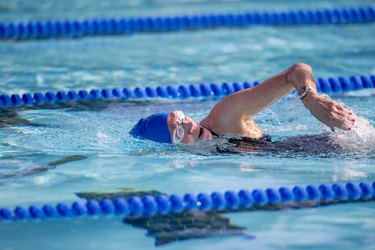
Swimming and walking are both excellent forms of cardio exercise that have their own benefits and drawbacks. But when it comes to calorie burning, swimming is the clear winner.
Compare exactly how many calories you burn when swimming versus walking and learn how you can increase the overall challenge of your workouts.
Video of the Day
Video of the Day
Does Swimming Burn More Calories Than Walking?
The calories you burn during any activity varies depending on a variety of factors, including your height, weight and fitness level (among others), according to Harvard Health Publishing. So, one person may burn more calories after a half hour of swimming than another.
Generally though, swimming burns more calories than walking, especially if you're swimming with a little extra intensity (like swimming laps, rather than a leisurely dip). Use the chart below to estimate about how many calories you can expect to burn after a half hour of walking, swimming and swimming laps.
Swimming vs. Walking Calories Burned in 30 Minutes
125 lbs | 155 lbs | 185 lbs | 215 lbs | 245 lbs | |
|---|---|---|---|---|---|
Walking | 107 calories | 133 calories | 159 calories | 184 calories | 210 calories |
Swimming | 180 calories | 216 calories | 252 calories | 293 calories | 334 calories |
Swimming Laps | 300 calories | 360 calories | 420 calories | 488 calories | 556 calories |
Why Swimming Burns More Calories Than Walking
Both swimming and walking are excellent forms of aerobic exercise, according to the Centers for Disease Control and Prevention (CDC). And you can use both activities to help you accomplish 150 minutes of steady state cardio per week, as the CDC recommends for overall health.
But whereas walking is a steady form of movement, swimming incorporates your entire body, which is more strenuous. Especially if you're swimming laps with a little more intensity, you can burn some serious calories.
Water also adds resistance, so when you swim, you're actually building strength, too. The resistance element is another reason why swimming tends to burn more calories than walking.
Calories Burned for Different Types of Swimming
Whereas there's really only one way to walk, swimming has multiple different strokes, according to Sport England. Some strokes (like the butterfly) are more challenging than others (like the breaststroke), which can also affect your overall calorie burn while you swim laps.
Approximate Calories Burned per Half Hour by Stroke Style
Breaststroke | Backstroke | Front Crawl | Butterfly |
|---|---|---|---|
200 calories | 250 calories | 300 calories | 450 calories |
Benefits of Swimming vs. Walking
As mentioned above, both swimming and walking are forms of cardiovascular activity, which is necessary for overall health, helping decrease your risk of developing chronic disease, like heart disease and diabetes, according to the CDC.
Walking is a budget-friendly activity, too. You don't need a facility or any extra equipment — a good pair of walking shoes should do the trick. And you can easily increase or decrease the intensity, depending on your current fitness level.
Swimming is a more intense workout, thanks to the added resistance of the water. So, you build strength while improving your cardio fitness. Plus, it's a low-impact movement form, so swimming can be better for those with sensitive joints. But unlike walking, swimming does require some skill and technique, as well as a pool (or body of water), so it's not necessarily accessible for all.
How to Increase Your Calorie Burn
Amping up the intensity of your swim or run can help boost your total calorie. Add quicker, timed intervals to your walk or swim by either speed walking or swimming at a faster tempo. Follow quick intervals with a slower recovery interval to catch your breath. In general, you want to try to make your rest periods shorter than your challenging intervals (but feel free to adjust as needed).
When walking, wearing a weighted vest or carrying hand weights is another way to add some challenge. While you don't want to wear weights when swimming, you can use hand paddles to make your strokes a little more difficult.